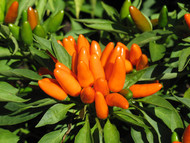4. Green Onions (Scallions)
Green onions are one of the easiest vegetables to grow—just as they are one of the easiest vegetables to regrow from scraps.
They are unfussy and will thrive in basically any container; just make sure the container drains well.
When it comes time to harvest, invest in a sharp harvesting knife and enjoy fresh, crisp scallions atop baked potatoes, in scallion pancakes, or in omelettes.
5. Potatoes
While potatoes generally aren’t thought of as container vegetables, both white and sweet potatoes grow exceptionally well in grow bags.
Like asparagus, potatoes like to always be covered by soil as they grow. Container gardening makes it easy to keep an eye on—and correct, if necessary—this soil level. If you notice your container is looking a little low on soil as your potatoes grow, just scoop some more soil on top with your favorite, high-quality trowel and your potatoes will stay very happy, indeed!
Pro tip: just keep an eye on the moisture level of your soil, as soil dries more quickly in containers than it does in the ground. This 4-in-1 soil tester will help you keep your soil exactly where it needs to be!
6. Cauliflower
Like eggplant, cauliflower requires large containers and careful watering—but once it has those two things, it does fare quite well in pots or raised planters.
Cauliflower is a heavy feeder, so the richer your soil, the happier your heads will be. That’s where the 124-Gallon Plastic-Free Composter from Garrett Wade comes in. With its open-air design, wood and galvanized steel construction, and generous 124-gallon capacity, this composter helps you turn kitchen scraps, yard waste, and coffee grounds into rich, fertile compost—no plastic, no accelerator needed. Use that compost to nourish your cauliflower (and everything else in your garden).
7. Lettuce
Almost all varieties of lettuce can be grown successfully in containers. You can sow lettuce directly into your containers or you can transplant more mature plants.
If you decide to transplant your lettuce, invest in an heirloom-quality garden transplant trowel, water well, and wait.
Many varieties of lettuce can be harvested multiple times during a single growing season, so grab a pair of spring-loaded garden scissors and get ready for crisp, delicious container-to-table salads every night.
8. Radishes
Radishes don’t love the heat, so start them outside in containers early, or inside, where it’s cooler, all summer and spring. Just choose a container that’s at least six inches deep to allow for the proper formation of roots.
To water, invest in a terracotta watering vessel that will properly hydrate the plants without overwatering them. Soil that’s too wet can result in rotten radishes, so it is important to watch your soil here closely. Moist is the goal; wet never is.
9. Peas
Peas—in particular, sugar snap peas—are one of my personal favorite vegetables to grow in containers. They deliver a high yield for minimal effort, and even feature beautiful little white flowers along the way.
Invest in a high-quality pair of gardening gloves, a sturdy trowel, and start planting! Eventually, your peas will need a support structure, too. You can easily make your own with five to seven sticks. Just gather the sticks and arrange them in a triangular shape, secure them together with twine, and voila! Your peas are ready to climb.
10. Carrots
Carrots are so fun to grow—especially in containers—but they require a little more care than the other vegetables I’ve mentioned.
First, carrots do not tolerate transplanting, so you will need to start with seeds. Grab a packet of carrot seeds from your seed library and get started. Germination takes between two to three weeks, at which point you may notice your seedlings starting to crowd one another. To thin things out, I like to use a pair of thread scissors to gently remove weaker-looking plants to help the stronger ones really thrive.
From there, growing carrots in containers is just like growing anything else: Watch your carrots closely, water them regularly, and wait for the wonder. It’s coming—with a crunch.



